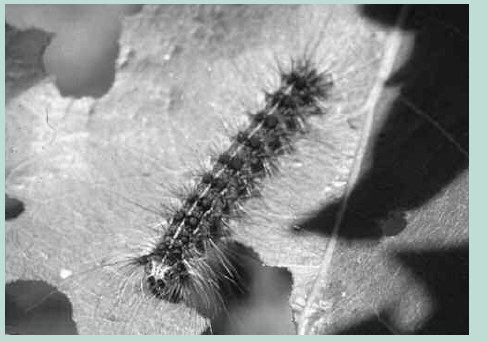
Summer 2008
Volume 17 No. 2
Gypsy Moth Treatment in Hoosier National Forest
by Philip T. Marshall and Angela Rust
Gypsy moth is a well known pest to people living in Allen
County, other northeastern counties, and the northeastern U.S., but many people
living in southern Indiana may not be familiar with this pest. Gypsy moth
caterpillars feed on over 500 species of plants including many tree and shrub
species. Oaks are the preferred host but apple, basswood, willow and poplar are
also preferred followed by maples, hickory and other hardwoods.
Caterpillars feed from late April through late June. Defoliation during this time of greater than 50% occurring over 2-3 years can cause dieback and death of the tree. The adult gypsy moths do not cause damage, but get their name from the fact that female moths will lay egg masses on cars, recreational vehicles, other outdoor articles, firewood and logs and then travel on these items from infested areas to non-infested areas.
The Indiana Department of Natural Resources and its partners have surveyed for gypsy moth across Indiana every year since the 1970’s. Pheromone (a chemical scent secreted by the female moth to attract the male moth) traps are placed throughout each county to detect the presence of gypsy moth. The traps are baited with a small plastic string containing the pheromone and two sides inside the trap are sticky to catch any male moths that enter the trap. The traps provide several types of information - whether or not gypsy moth is present in the area, how high the population is and if a reproducing population is developing in the area.
In 2006, gypsy moth was detected in the Hoosier National Forest in Monroe County. In 2007, additional traps were placed around the 2006 detection area. In evaluating the trap data from the 2007 season, it was determined that there was a very low level population of gypsy moth developing in the area and that treatment of the area was prudent. In the evaluation of moth catch data and other factors, it was determined that mating disruption using pheromone flakes could provide the
eradiation of gypsy moth from the area. Eradication is the goal for this area because it is over 150 miles in front the generally infested area of northeastern Indiana. On June 23, 2008, the USDA Forest Service Slow The Spread Program treated the area with pheromone flakes. Pheromone flakes are small plastic flakes, 1 x 3 mm, which contain the scent of the female gypsy moth. They are released by aircraft over the tops of the trees. This abundance of pheromone which will remain over the following 8-12 weeks makes it difficult for the male moths to orient and find a female moth to mate with.
Was it necessary to treat for gypsy moth in the Hoosier National Forest and the adjoining private lands? Yes, because this population was so far in front of the gypsy moth populations in northern Indiana and Ohio, that to let the population grow unchecked, would produce a new gypsy moth front and would defeat the success of Indiana’s gypsy moth management goal to slow the spread of gypsy moth. Also, this population is in the “heart” of Indiana’s main forest area which is predominately occupied by oaks which is gypsy moth’s favorite food and a major economic and ecological timber resource in Indiana.
Gypsy moth is not native to the United States and originates from Europe. Since this insect is not native, when it enters a new area many of its natural enemies do not come with it. They lag behind and can not quickly catch up to help hold down the damage gypsy moth can create. Recent management of gypsy moth in the U.S. is in large part a preventative program that slows gypsy moth down and allows the natural enemies to keep up. Since 1988, Indiana’s gypsy moth management goal has been to Slow The Spread and Development of gypsy moth. In 1999, Indiana joined the U.S. Forest Service Gypsy Moth Slow The Spread (STS) Program and utilizing the resources of the STS Program has kept the spread rate under 4 miles per year and in some years a negative spread rate.
The mating disruption treatment in the Hoosier National Forest will help to maintain the success of Indiana’s gypsy moth management program. The treatment site is monitored during the year of treatment and the following year. The results of this treatment will be known after the 2009 survey is completed.
Phil Marshall, State Entomologist, and Angela Rust, Nursery Inspector and Compliance Officer, are with Indiana Department of Natural Resources, Division of Entomology and Pathology